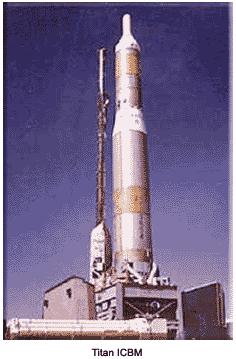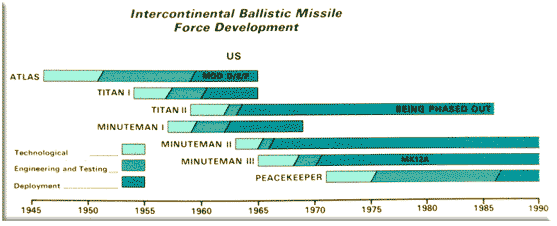A ballistic missile is powered early in its flight and then follows a non-powered trajectory to its target. During the Cold War, both the United States and the Soviet Union developed inter-continental ballistic missiles, known by the acronym ICBM, that were capable of reaching any target in each other's territory. ICBMs could deliver nuclear weapons in a manner that was virtually immune to defensive measures. Arms limitations treaties between the superpowers have reduced the number of ICBMs deployed by each side.
 Military interest in ballistic missiles was aroused by the success of German scientists during World War II. The V-2 rocket was launched late in the conflict and proved that, although not very accurate at that time, ballistic missiles could reach their targets without any effective interference by defenses.
After the war, the United States made a strenuous effort to collect the remaining materials of the V-2 Program, along with Wernher von Braun and his team of German scientists and engineers. The Germans provided the initial nucleus of the American ballistic missile program after the war.
An alternative technology to ballistic missiles is that of cruise missiles, which use rocket propulsion but have wings. For several years after World War II, cruise missiles were favored. The development of two cruise missiles, "Snark" and "Navaho," were funded at much higher levels than the first ballistic missiles.
However, the cruise missiles proved to be unreliable with the technology of the time, and studies indicated that better accuracy and reliability could be achieved with ballistic missiles. As a result, the Air Force launched a study in 1951, towards the development of a two-stage ballistic missile with a minimum range of 5,500 nautical miles. The study marked the beginning of the Atlas Missile Program.
Conventionally, ICBM is a term used only for land-based systems, in order to differentiate them from submarine-launched ballistic missiles (SLBMs), which can also have an intercontinental range. As of this writing, only three countries have operational ICBM systems: the United States, Russia, and China. Other nations have ICBMs but not an organized ICBM system.
From 1951 to 1954, the Atlas project was poorly funded and had a low priority. However, in late 1953, the Atomic Energy Commission achieved a breakthrough in nuclear weapons, making smaller and lighter bombs available. In early 1954, studies by the von Neumann Committee and the RAND Corporation both recommended that the Air Force pursue ICBMs. Project Atlas was given the Air Force's top priority status in May 1954. President Dwight D. Eisenhower elevated it to the highest national priority in September 1955.
Military interest in ballistic missiles was aroused by the success of German scientists during World War II. The V-2 rocket was launched late in the conflict and proved that, although not very accurate at that time, ballistic missiles could reach their targets without any effective interference by defenses.
After the war, the United States made a strenuous effort to collect the remaining materials of the V-2 Program, along with Wernher von Braun and his team of German scientists and engineers. The Germans provided the initial nucleus of the American ballistic missile program after the war.
An alternative technology to ballistic missiles is that of cruise missiles, which use rocket propulsion but have wings. For several years after World War II, cruise missiles were favored. The development of two cruise missiles, "Snark" and "Navaho," were funded at much higher levels than the first ballistic missiles.
However, the cruise missiles proved to be unreliable with the technology of the time, and studies indicated that better accuracy and reliability could be achieved with ballistic missiles. As a result, the Air Force launched a study in 1951, towards the development of a two-stage ballistic missile with a minimum range of 5,500 nautical miles. The study marked the beginning of the Atlas Missile Program.
Conventionally, ICBM is a term used only for land-based systems, in order to differentiate them from submarine-launched ballistic missiles (SLBMs), which can also have an intercontinental range. As of this writing, only three countries have operational ICBM systems: the United States, Russia, and China. Other nations have ICBMs but not an organized ICBM system.
From 1951 to 1954, the Atlas project was poorly funded and had a low priority. However, in late 1953, the Atomic Energy Commission achieved a breakthrough in nuclear weapons, making smaller and lighter bombs available. In early 1954, studies by the von Neumann Committee and the RAND Corporation both recommended that the Air Force pursue ICBMs. Project Atlas was given the Air Force's top priority status in May 1954. President Dwight D. Eisenhower elevated it to the highest national priority in September 1955.
 Along with Atlas, the United States developed the Titan, an even larger ICBM. Both were liquid fueled.
The original plans for deployment went through several changes. Eisenhower approved a plan in March 1957, for 40 Atlas and 40 Titan missiles. After the launch of Sputnik later that year, an "emergency" plan was adopted that called for deployment of the first Atlas missiles in June 1959, with 123 ICBMs. These were to consist of nine Atlas squadrons and four Titan squadrons to be operational by March 1963. By October 1961, the Strategic Air Command had actually activated 13 Atlas and six Titan squadrons.
Liquid oxygen and kerosene fuel propulsion posed several problems. The fuel was dangerous and corrosive, and the missile silos were difficult and expensive to maintain.
To overcome these obstacles, development was begun in the late 1950s on a missile powered by solid fuel. The result was the Minuteman ICBM. This was first deployed in the early 1960s, and soon replaced the liquid-fuel ICBMs in the United States' defense arsenal. At their peak, 1000 Minuteman ICBMs were on active status.
The final generation of American ICBMs was the MX Peacekeeper ICBM. The idea of a solid-fuel rocket, whose deployment could be mobile, was first discussed in the 1960s. The decision to actually develop one was made in late 1971, and the project was launched in February 1972, under the name "Missile Experimental," or "MX."
Plans were made to base the MX on a huge "racetrack," on which the actual missiles would be moved randomly to various launch points, so that the Soviets would never know their exact location. The cost was high, the land requirement was vast, and the option was eventually abandoned in favor of fixed launch sites. After the missile was made operational, the Air Force re-designated it the "Peacekeeper."
Under the terms of SALT II, the Peacekeeper was taken out of service. The operational ICBM capacity of the United States now consists only of the Minuteman III, the most recent version of the original solid fuel ICBM.
Along with Atlas, the United States developed the Titan, an even larger ICBM. Both were liquid fueled.
The original plans for deployment went through several changes. Eisenhower approved a plan in March 1957, for 40 Atlas and 40 Titan missiles. After the launch of Sputnik later that year, an "emergency" plan was adopted that called for deployment of the first Atlas missiles in June 1959, with 123 ICBMs. These were to consist of nine Atlas squadrons and four Titan squadrons to be operational by March 1963. By October 1961, the Strategic Air Command had actually activated 13 Atlas and six Titan squadrons.
Liquid oxygen and kerosene fuel propulsion posed several problems. The fuel was dangerous and corrosive, and the missile silos were difficult and expensive to maintain.
To overcome these obstacles, development was begun in the late 1950s on a missile powered by solid fuel. The result was the Minuteman ICBM. This was first deployed in the early 1960s, and soon replaced the liquid-fuel ICBMs in the United States' defense arsenal. At their peak, 1000 Minuteman ICBMs were on active status.
The final generation of American ICBMs was the MX Peacekeeper ICBM. The idea of a solid-fuel rocket, whose deployment could be mobile, was first discussed in the 1960s. The decision to actually develop one was made in late 1971, and the project was launched in February 1972, under the name "Missile Experimental," or "MX."
Plans were made to base the MX on a huge "racetrack," on which the actual missiles would be moved randomly to various launch points, so that the Soviets would never know their exact location. The cost was high, the land requirement was vast, and the option was eventually abandoned in favor of fixed launch sites. After the missile was made operational, the Air Force re-designated it the "Peacekeeper."
Under the terms of SALT II, the Peacekeeper was taken out of service. The operational ICBM capacity of the United States now consists only of the Minuteman III, the most recent version of the original solid fuel ICBM.
